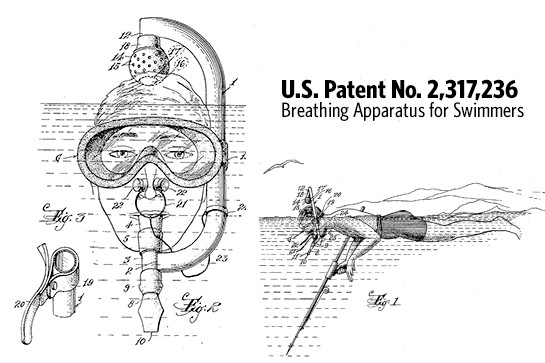
At the Beach
At the Beach
I can still relive the excitement from the last time I visited the ocean: pulling off the interstate after a long drive to see gulls flying by, a quick rolling down of the windows to flush the stale car air with a salty-sandy mixture that seems to bring high-tide to the worry-filled mind. It’s beach time and whether you relax with a cold drink and a book in a hammock or by cruising the waves out past the buoys, you will be using an invention that was once just a patent waiting to be issued.
Note: This article is part of an ongoing series detailing some of the Inventors Eye staff’s favorite patents. For each article, the writer selects their five favorite patents under a given theme. This list is from Office of Innovation Development extern James Higgins.
Breathing Apparatus for Swimmers
U.S. Patent No. 2,317,236
One of my favorite things to do while at the beach is to search for sand dollars in the deeper waters. For me, a key piece of equipment for this activity has always been a snorkel. Patented by Charles H. Wilen and Alexandre Kramarenko on April 20, 1943, the snorkel was initially used as a tool to facilitate spear fishing. Instead of swimmers having to lose eye contact with their possible prize while they caught their breath, they were now able to keep their face and focus underwater for long periods of time. This piece of equipment is a key part of any beach toy arsenal.
Metalloscope
U.S. Patent No. 2,066,561
Before it was used to scour beaches for buried treasure, the metal detector was hastily created by Alexander Graham Bell for a different purpose. President James Garfield, who had been shot in an assassination attempt, had a bullet lodged in his back. Bell attempted to locate the bullet using his new invention, but he was unable to distinguish the metal of the bullet from the metal springs supporting the surface on which Garfield was resting. Garfield eventually succumbed to the assassin’s bullet, but this "live" test established the groundwork for Gerhard Fisher to patent a more modern device, a “metalloscope,” issued on January 5, 1937. Today, metal detectors can often be seen tracking bracelets, watches, or even an “X” on a map.
Hammock
U.S. Patent No. 552,229
Although the hammock can be traced back centuries ago to Central and South America (and was one of the first things to catch the eye of Christopher Columbus), the standard hammock was patented by John A. Bidwell on December 31, 1895. Since then, it has been used across the globe and even during the construction of the Panama Canal where they were easily encased by mosquito nets to protect the sleeping workers. Of course, today it is mainly used near the coastlines. Tie one up between two palm trees, add the sound of crashing waves in the background, and you will be rocking to sleep in no time.
Power-Driven Aquatic Vehicle
U.S. Patent No. 3,426,724
If you prefer a more action-filled beach venture, you may have found yourself on this invention once or twice. Clayton J. Jacobson, a man looking for thrills on water comparable to a skin-shaving experience on his motorcycle, patented the Sea-doo on February 11, 1969. His invention offered a similar adrenaline bump with a lower risk of injury. The Sea-doo was designed to be able to function in shallow waters and be safe to use around swimmers. This invention has turned into a nice alternative for those who like their vacations a little more lively.
Insulated Beverage Cozy
U.S. Patent No. 4,293,015
Throughout the 20th century, beachgoers struggled with keeping their beverages cold. The portable ice box helped a bit, but if a vacationer wanted to go for a swim or play volleyball mid-drink, it was going to be hotter than blue blazes on their return. The country needed a bright mind to step up and solve this problem. Bonnie McGough answered the call with her Insulated Beverage Cozy, patented October 6, 1981. Its simple design with insulated fabric made it cheap, effective, and durable. No longer would warm half-filled cans plague the soft sand of America’s beaches.
Whether you find yourself dipping your toes in the ocean or taking a snooze on a hammock, raise your cold drink not only to Bonnie McGough, but to all of the inventors who have improved the beach experience forever.
The USPTO gives you useful information and non-legal advice in the areas of patents and trademarks. The patent and trademark statutes and regulations should be consulted before attempting to apply for a patent or register a trademark. These laws and the application process can be complicated. If you have intellectual property that could be patented or registered as a trademark, the use of an attorney or agent who is qualified to represent you in the USPTO is advised.


